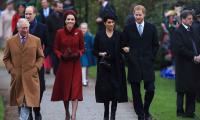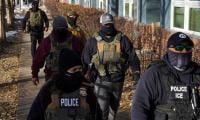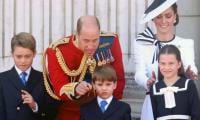US bans visas for citizens of seven Muslim countries
Complete ban imposed on Muslim refugees; wall to be constructed on Mexican border; Trump starts fulfilling his pledges; invites Modi to visit US; says US considers India a true friend; Modi vows to work closely with US
WASHINGTON: US President Donald Trump took a first step toward fulfilling his pledge to "build a wall" on the Mexican border on Wednesday, signing two immigration-related decrees.Trump visited the Department of Homeland Security to sign an order to begin work to build a large physical barrier on the southern border and impose a temporary ban on visas for citizens of seven Muslim countries in the Middle East and Northern Africa, a move which some reports indicate could just be the beginning of further limits.
According to officials who have been briefed on the matter, the executive order, the ban will exclude all people from Iran, Iraq, Syria, Somalia, Sudan, Libya, and Yemen from visiting the United States. It is also to include a total ban on Muslim refugees entering the United States from anywhere, with some exceptions for religious minorities.
Trump campaigned on the idea of banning all Muslims from entering the United States, and while he’s said to have moderated on that position since then, this appears to be at least the start of a policy in that vein. At the same time, the ban list has some conspicuous absences.
Despite presenting such moves as a national security measure intended to prevent terror, the nations from which 9/11 plotters originated (primarily Saudi Arabia, but also including Egypt and the UAE) were left off the new ban. Also, while the US may fear blowback from wars in Iraq and Syria, and constant drone strikes in Yemen, they did not include Afghanistan, 15 years into America’s occupation, nor Pakistan, which has borne the brunt of America’s drone war.
It is thus very difficult to figure exactly how they came by this list, with nations like Iran seemingly just included for political value, and the other countries on the list just sounding scary.
Earlier, Indian Prime Minister Narendra Modi pledged to work closely with Donald Trump after the new US president invited him to Washington, looking to ensure an upturn in ties survives a change at the White House.
After their first phone call since Trump’s inauguration, the leaders of the world’s two largest democracies both indicated they had had a warm conversation and extended mutual invitations to their respective capitals. But while both leaders share similar backgrounds as establishment outsiders, analysts say their two governments could clash on issues such as trade and visas for Indians wanting to work in the United States.
Statements issued after Tuesday night's phone call indicated both men are keen to build on the recent improvement in ties that began under Trump's predecessor Barack Obama.
Writing on Twitter, Modi said he "had a warm conversation" with the new US president and they had "agreed to work closely in the coming days to further strengthen our bilateral ties". "Have also invited President Trump to visit India," Modi added after the White House revealed Washington had extended a similar invitation.
Modi, a Hindu nationalist, was effectively barred from the United States for years after deadly communal riots in thewestern state of Gujarat during his time as chief minister. Most of those killed were Muslims.
But after his landslide election victory, Modi built a strong rapport with Obama who became the first sitting US president to pay a second visit to India during the 2015 Republic Day celebrations.
A surprisingly convivial conversation in November between Trump and Prime Minister Nawaz Sharif caused alarm within Modi’s administration.
But during the call, Trump emphasised the United States "considers India a true friend and partner in addressing challenges around the world," according to a White House readout of the call.
"The two discussed opportunities to strengthen the partnership between the United States and India in broad areas such as the economy and defence. President Trump looked forward to hosting Prime Minister Modi in the United States later this year," it said.
Several commentators have argued that Modi and Trump should have a natural affinity as political outsiders who have risen to power in part by castigating the traditional ruling elite on a nationalist platform. Trump's chief strategist Steve Bannon described Modi's victory in India's 2014 general election as the first phase in a "global revolt" against the existing order that culminated with Trump's victory in November.
But in a speech last week, Modi castigated "rising parochial and protectionist attitudes" which was interpreted as a dig at Trump who has vowed to put "America first" as his governing mantra. Modi's flagship "Make In India" policy is designed to fire up his country's manufacturing sector and ramp up exports, a goal that appears at odds with Trump's protectionist instincts.
Major US firms such as Walmart and Apple have in turn grown frustrated by the regulations and tariffs imposed by Indian authorities as they seek to crack what is a potentially massive market.
Rajrishi Singhal, a Mumbai-based geopolitical analyst, said other potential problem areas included Trump's reservations over an existing visa scheme allowing high-skilled foreign workers into the US.
"There are also issues with the pharma industry -- the US thinks our patent regime is too lenient -- and the US wants access to the Indian agriculture market," he told AFP.
"These issues have been on the boil for the last few years. It won't result in a trade war right away as the leaders will gauge each other first. Later, maybe a year down the line, we will have to see," he said.
During his election campaign, Trump courted Indian-American voters and even released a campaign advertisement in Hindi for Diwali, the Hindu festival of lights -- albeit in a thick US accent.
The new president's hardline rhetoric towards Muslims during his campaign found favour in some quarters in India, which has had its fair share of tensions between the majority Hindu population and its Muslim minority.
Paranjoy Guha Thakurta, editor of India's Economic and Political Weekly, said there were "uncanny similarities" between Modi and Trump who both "have scant regard for the minorities and the media". "They are two highly polarising figures," he added.
-
 First Poll Since King Charles' Action Against Andrew Reveals Royal Family's Public Standing
First Poll Since King Charles' Action Against Andrew Reveals Royal Family's Public Standing -
 Blake Lively Strengthens Legal Team Ahead Of Justin Baldoni Trial
Blake Lively Strengthens Legal Team Ahead Of Justin Baldoni Trial -
 'Back To School!': Palace Shares Details Of Princess Anne's Latest Engagements
'Back To School!': Palace Shares Details Of Princess Anne's Latest Engagements -
 Paul Mescal Clarifies Acting Break Comment As He Teases Paul McCartney Role
Paul Mescal Clarifies Acting Break Comment As He Teases Paul McCartney Role -
 Kate Middleton's Unexpected Style Of Arrival At Solo Outing Goes Viral
Kate Middleton's Unexpected Style Of Arrival At Solo Outing Goes Viral -
 Why ‘X’ Is Down? Thousands Report Twitter Outage: Here’s What You Can Do
Why ‘X’ Is Down? Thousands Report Twitter Outage: Here’s What You Can Do -
 Florida Man Held After Alleged Nail-scattering On Busy Intersections
Florida Man Held After Alleged Nail-scattering On Busy Intersections -
 Valeria Nicov: Sean Penn's Athletic Girlfriend Raises Eyebrows With Latest Photos
Valeria Nicov: Sean Penn's Athletic Girlfriend Raises Eyebrows With Latest Photos -
 Sharon Stone Lashes Out At Fellow Award Show Attendees After Stealing Accusations
Sharon Stone Lashes Out At Fellow Award Show Attendees After Stealing Accusations -
 Gwyneth Paltrow Reveals Real Reason She Said Yes To 'Marty Supreme'
Gwyneth Paltrow Reveals Real Reason She Said Yes To 'Marty Supreme' -
 King Charles Says He And Queen Camilla Stand With People Of Ukraine
King Charles Says He And Queen Camilla Stand With People Of Ukraine -
 Ben Affleck Argues In Favour Of His Shirtless Scene In 'The Rip'
Ben Affleck Argues In Favour Of His Shirtless Scene In 'The Rip' -
 Mississippi Postal Worker Arrested After Complaints Of Marijuana Odour In Letters
Mississippi Postal Worker Arrested After Complaints Of Marijuana Odour In Letters -
 Canada, China Lock Initial Trade Deal On ‘EV,Canola’ To Strengthen Ties: What To Expect Next?
Canada, China Lock Initial Trade Deal On ‘EV,Canola’ To Strengthen Ties: What To Expect Next? -
 Melissa Leo On Euphoria Of Winning An Oscar Vs It's Impact On Career
Melissa Leo On Euphoria Of Winning An Oscar Vs It's Impact On Career -
 Meghan Markle, Prince Harry Express 'hope' In Latest Major Statement
Meghan Markle, Prince Harry Express 'hope' In Latest Major Statement



